
Renowned Puerto Rican artist, Miguel Luciano works in multiple media to examine issues of cultural identity, politics, and popular culture. BRIC presents Luciano‘s new work – sculptures featuring customized vintage Schwinn bicycles – that commemorate the traditions of Puerto Rican bike clubs in New York. His exhibition features this work along with paintings and historic ephemera that question the colonial relationship between the United States and Puerto Rico, at the centennial mark of U.S. Citizenship for Puerto Ricans (1917-2017). With each bicycle in the show, the year and color of the bicycle are key references to associations with Puerto Rican history and politics, both on the island and in the U.S. This body of work acts as a powerful commentary on the current economic and political crisis in Puerto Rico and examines its impact on the diaspora.
On March 2, 1917, Wilson signed the Jones-Shafroth Act, under which Puerto Rico became a U.S. territory and Puerto Ricans were granted statutory citizenship, meaning that citizenship was granted by an act of Congress and not by the Constitution (thus it was not guaranteed by the Constitution). It also created the Senate of Puerto Rico, established a bill of rights, and authorized the election of a Resident Commissioner. Today, commemorating 100 years of the Jones Act, Miguel Luciano speaks about his work and his take on Puerto Rico’s political history.
Marlena Fitzpatrick: What moved you to use Schwinn bicycles to tell the political history of Puerto Rico?
Miguel Luciano: These are all vintage Schwinn bikes from the 50’s- to the 70’s that are recreated as new sculpture. These bikes have been completely remade, restored, customized and turned into these sculptural objects. I rebuilt them in the tradition of the Puerto Rican Schwinn Clubs. This is something ongoing, a past time, a tradition of the Puerto Rican clubs that have been in New York for 30-plus- years, so there’s maybe three generations of Puerto Rican Schwinn Club riders and members.
MF: Are you a member?
ML: No, not officially. I know a lot of guys from these clubs, because I lived in Bushwick for a long time. The headquarters of the oldest clubs were in Bushwick. There are also groups in the South Bronx and the Lower East Side, but it’s something that’s been disappearing as folks get older. I’m paying homage to that tradition and using the bikes to look at our history; what was going on in the 50’s, 60’s and 70’s in Puerto Rico (P.R.) and in the United States (U.S.)
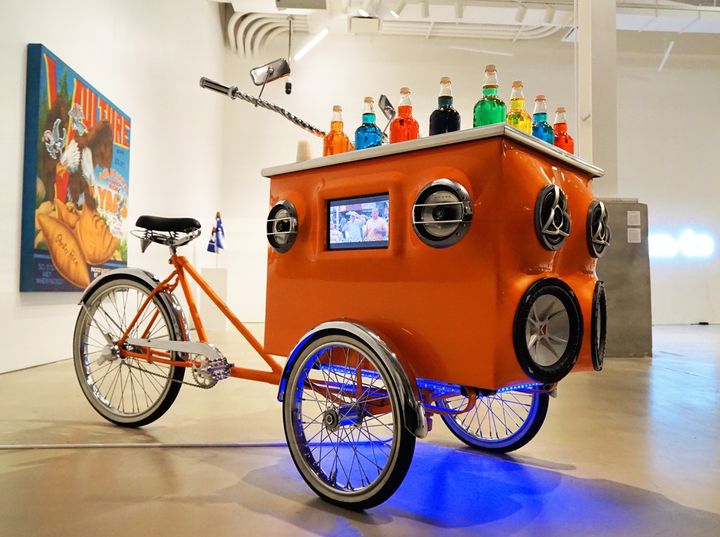
Pimp my Piragua, 2009
MF: Why the title ‘Ride or Die’?
ML: Ride or Die is about urgency. It’s about riding on the one hand, which is symbolically about freedom. Especially when you’re a kid riding your bike it’s your first sense of freedom. Your first experience when you get a new bike is to go out on your own. You get to travel in a new way— in a new kind of freedom— when you have wheels underneath.
MF: To me the title also evokes the issue you mentioned: the dying tradition, in this case, of the Schwinn Club.
ML: Yes. The way Puerto Rican culture survives, and the way that it’s celebrated in this bike club tradition, it’s classic vintage Americana that gets reinvented and inscribed with Puerto Rican symbolism. It becomes an emblem of Puerto Rican pride. It’s something classically “American” and transformed into something distinctively Puerto Rican. That process for me has always been important. It’s a process of resistance that insists seeing us within the objects that have been defined classically American. Ride or Die also means “to show up, and to be there.” It means that someone “has your back.” That’s also a vernacular expression that means to be faithful and loyal; to show up when the time is needed. It’s about unity and standing up. Each bike is symbolic of a particular moment in our history that I want to look at critically.
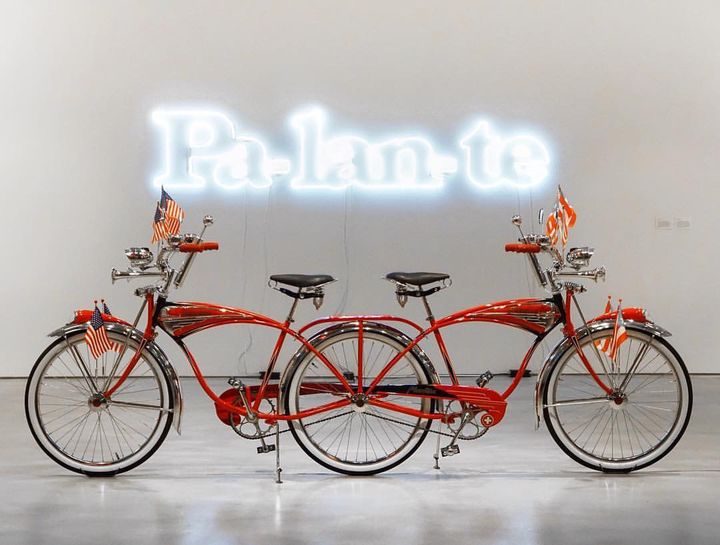
Double-Phantom / Entro-P.R., 2017
MF: Let’s start with the masterpiece, the center of attention.
ML: The Double-Phantom / Entro-P.R., 2017 is literally two Phantoms that are joined together. They’re from 1952, the year of our Constitution in Puerto Rico. It’s red, the color of El Partido Popular Democrático (PPD). That’s the foundation of Estado Libre Asociado— E.L.A. (Commonwealth). In that sense, historically, there’s a lot of nostalgia of that moment. The moment represents this historic union.
MF: Or as some in the island would call it: “The best of both worlds.”
ML: Exactly. Luis Muñoz Marín (former governor) is viewed very romantically. He’s credited as the governor that put shoes on the feet of the barefoot. There’s nostalgia associated with that era, despite the fact that the promise of this new union– I think they felt more optimistically then- never came to fruition. It didn’t take long for people to see the problems and contradictions in this neo-colonial contract. Also, the 1950’s were about the promise of modernity within American culture. For example, the cars from the 1950’s were promoted all over the world as symbols of American innovation and status. They’re beautiful objects.
MF: So, if I were to ride that bike, I’d be worried because I see two opposite chains and a middle wheel. Where will it go? Will I get hurt, for example?
ML: That’s the paradox. The bike has two fronts and one back. It cannot go forward, without also going backwards. If two opposite sides are trying to move at the same time it goes nowhere. One side is the U.S. and the other is P.R. We are in this perpetual kind of tension that inhibits forward mobility, right? That’s the paradox and the present. That’s the problem with E.L.A. Nowadays there’s skepticism or ambivalence about the nature of this relationship.
MF: So, it kind of forces you to stay still and conform.
ML: There is a tension between beauty and dysfunction here. All of it has kind of fallen apart or least the veil has been lifted, especially with PROMESA. The end of 2016 questions anything stable from this relationship. With PROMESA we now have ‘La Junta,’ the fiscal control board, that implements a body of U.S. appointed officials that have power over the P.R. government.
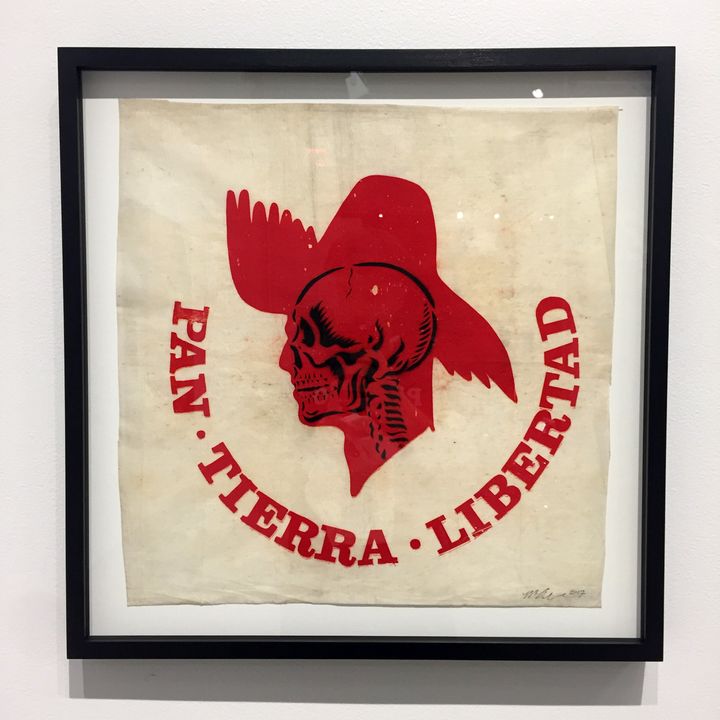
Ni Pan, Ni Tierra, Ni Libertad (Neither Bread, nor Land, nor Liberty), 2017
MF: What’s the powerful significance of the year 1952?
ML: Before the 1950’s the U.S. appointed the leaders, governors and other officials. In 1952, we get to elect our own officials. So, there was a lot of excitement over the promise of greater autonomy. Many people thought there would be a transition towards independence at some point. This never came to be. We’re locked into this push-and-pull relationship that’s become very stagnated. But now, we have a situation with this new ‘Junta’ where they have really broad authority over the island’s affairs, power to create laws, and restructure the economy. This is like going back to pre-1950’s. The people are very uncertain about what it means for the status of E.L.A. and it undermines the Constitution and the entire Commonwealth agreement. That’s why at the center of the show is this paradox. In spite of this particular bike’s inability to move in any one direction, the message behind it in neon is Pa-lan-te, 2017.
MF: How did you build the sign?
ML: The neon I had made from the letters/logo of the first book about The Young Lords, 1970’s. We used the same font. It’s an ode to the Young Lords and that era. It’s remembering the history of our community’s resistance, which is very important now. That’s the theme of the show: looking back to the lessons of our past in order to learn from them, but also to see the possibilities of resistance in the present.
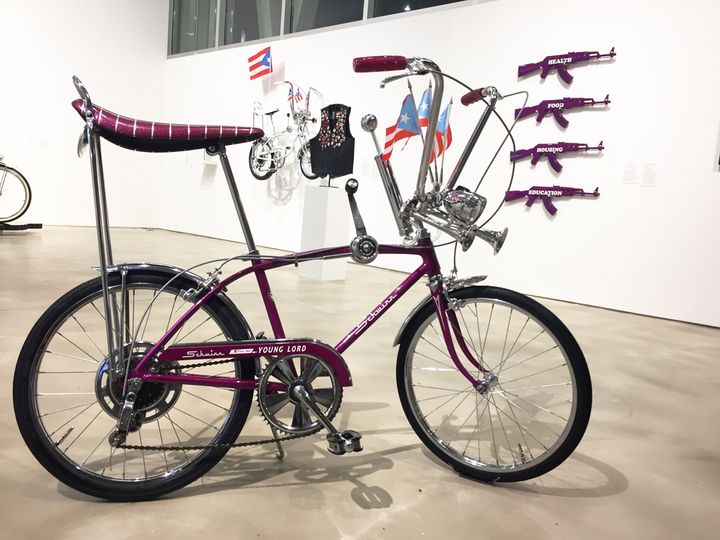
Young Lord, 2017 and Health, Food, Housing, Education
MF: Speaking The Young Lords, you have this cute purple bike. Why is it called The Young Lord?
ML: That’s the original color of this particular bike. It’s a 1969 Schwinn Fastback that was violet originally, and purple was the color of The Young Lords. 1969 is the year The Young Lords were founded in NY. So, here I made the word Young Lord appear on the chain guard decal. It’s also about imagining or encouraging young people to understand this history, given this bike is for young people. The homage transfers to the rifles on the wall Health, Food, Housing, Education. Those came from one of the original Young Lords posters from the early 70’s.
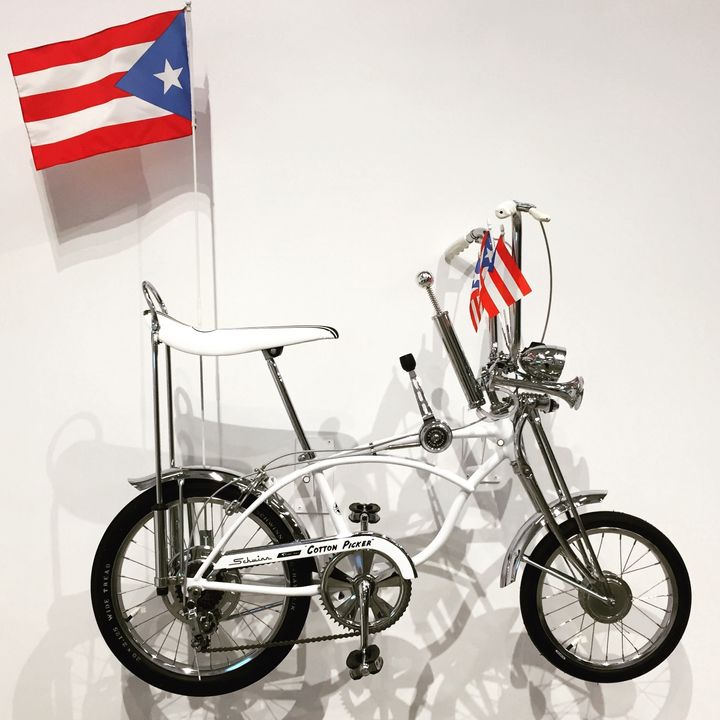
Porto Rican Cotton Picker, 2011
The white bike, Porto Rican Cotton Picker, is a krate bike from a series that came out around the same time. They were referenced to produce. The apple krate, for example, was a red bike. These are muscle, hot-rod like bikes that had the stick shift and they would move faster. This one is really problematic because it was originally called the “Cotton Picker.” Schwinn produced this bike in 1970, only until 1971; it was discontinued, because it didn’t sell well. It was politically incorrect, even in the 70’s. I used the bike as a way to look at another part of our history. What’s the relationship between Puerto Ricans and cotton picking? I was troubled by the thought of “what would it mean to have a “Cotton Picker” bike in the Puerto Rican Schwinn club, covered in Puerto Rican flags?”
MF: With this one they went overboard, didn’t they?
ML: Well, not just this one. They also had a yellow one called the “lemon peeler” and a green bike called the “pea picker,” all in the same series. So, they shift from the reference to produce into labor. They may have thought they were being clever with the coloristic associations, but oblivious and insensitive when it came to naming these bikes. That speaks to the way racism in American culture is often normalized. It’s offensive. It’s a racist association. Despite this, my challenge was to figure out the connection.
MF: And of course, that may be cheap labor.
ML: Right. One of the earliest labor programs from the island to the states was a program that brought workers from rural areas to pick cotton in Arizona in the 1920’s. They were brought in to replace Mexican workers. We were barely citizens at the time; just 10 years. That’s what prompted the cotton growers to look at P.R. for laborers to avoid immigration issues. But the people that arrived knew they had rights, and immediately protested because there were horrible living and working conditions. They successfully got some protections and improvements and it was one of the largest labor protests in Arizona’s history. The cotton growers canceled the labor program. Most of those workers went to California as migrant farm workers. The story then becomes about this vest.
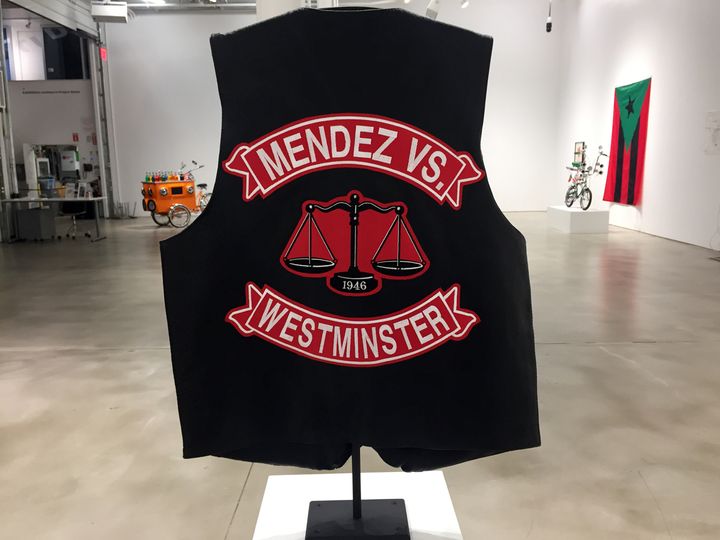
Freedom Rider, 2011
MF: The Young Lords vest, Freedom Rider, 2011.
ML: Felícita Méndez (1916-1998), migrated with her family in the 1920’s to Pima County, Arizona, to pick cotton. They eventually moved to California where Felícita married Gónzalo Méndez, a Mexican man who was a naturalized U.S.citizen, When their children were denied enrollment in the local public school due to segregation laws, the family sued the school district in 1946, Mendez v. Westminster. Ultimately, California Governor Earl Warren changed the law, making California the first state to desegregate schools, well before Brown vs. Board of Education changed laws nationally. This story evokes the long history of Puerto Ricans in the U.S., their work as migrant laborers, the discrimination they have faced, and their solidarity with national civil rights struggles. The story of social justice and activism keeps growing. But we don’t learn about all these interconnected stories; African-Americans, Puerto Ricans, Mexicans that have fought together in the same struggle.
MF: I can take everything you’re saying and apply to our current situation. Your art proves we’ve been here before and our resistance have caused an impact. We need to be more united to avoid another downfall or going back to these stories.
ML: Well, these objects are a reminder of the racism and inequality, but also that we’ve fought for equality and social justice in ways that are dramatic. It’s good the community still remembers. There is a generation, that’s still around, that went through the civil rights era. The historic memory and inter-generational conversations are very important right now. What we’re facing in America, in terms of this resurgence of white supremacist politics in government and power, is something that has happened in the past. It’s also something that can be combated and overcome. Part of that challenge lies in remembering the resistance.
MF: Those that have no clue of Puerto Rico’s colonial history are learning about it through you, an artist. Do artists have a responsibility to keep our history alive?
ML: I think all artists have a social responsibility to respond to the times we’re living in. That’s the way I like to think about the role of art. In these objects, as you peel back the layers, there are stories that are painful and others that are proud. I like to complicate those narratives. But it’s really about learning our history in a way that’s never been taught.
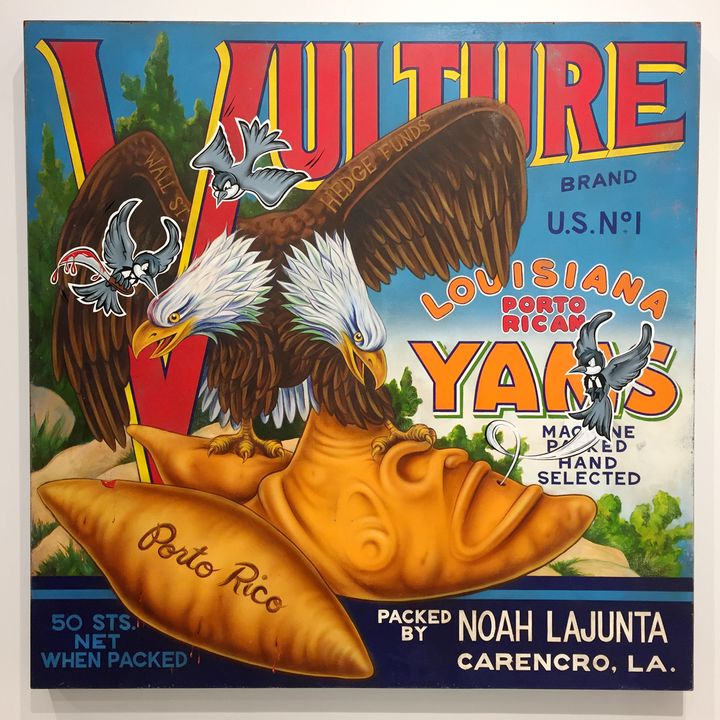
Vulture Brand Yams (Marca del buitre), 2017
MF: Now, let’s talk about the painting Vulture Brand Yams, 2017. It says “Louisiana Puerto Rican Yams.” What’s the Puerto Rican connection to New Orleans, Louisiana (NOLA)?
ML: The earliest Puerto Rican labor migration was to Hawaii to work on sugar plantations. But the first place Puerto Ricans came through was the port of NOLA. People would then travel by train all the way to San Francisco; then by boat to Hawaii. They’re importing people, and later on, fruits and vegetables. There’s a yam that became very popular in the 40’s or 50’s called the Louisiana Porto Rican yam, or Porto Rican sweet potato. These advertisements, yam labels, became the first images of Puerto Ricans in print and advertising. The painting intentionally looks like an antique advertisement. I’m also manipulating the way we perceive the past, and the present. This painting unpacks the crisis in P.R. right now. It was originally a “Victory” brand, but here it becomes “Vulture” brand. The eagle becomes a two- headed vulture, representing the banks and the hedge funds. The “Porto Rican” yams transform into a “Cemí” and are kind of our ancient ancestral spirit.
MF: And then you have angry piterres carrying machetes. It’s morbid, but it’s still trying to sell us something. And this painting is right beside another set of bikes.
![51’ [the promises are over], 2017 and Puerto Rican Flag in Black and White, 2017](https://img.huffingtonpost.com/asset/58b799171b00001a00b5b870.jpg?ops=scalefit_720_noupscale)
51’ [the promises are over], 2017 and Puerto Rican Flag in Black and White, 2017
ML: Yes, speaking of PROMESA and La Junta, the black and white bike alongside the black P.R. flag, represent another symbol of protest. The bike was made in 1951. Fifty-one is not only the number of statehood, but the year before E.L.A. It’s the end of an era in terms of the nationalist party. On the one hand it laments that history, and on the other it moves forward as a symbol of protest.
MF: What do the other two smaller bikes represent?
ML: The other two bikes are about the Partido Independentista Puertorriqueño (PIP) and Partido Nuevo Progresista (PNP). This is my fantasy of independence on the island, one that might have aligned with decolonizing movements in the Caribbean, the pan-African and black liberation movements. In the 20’s- when Pedro Albízu Campos was strong in P.R.- there was Marcus Garvey with these ideas of liberation that connected African descended people together. Whether in the states or in the Caribbean, there’s a movement to decolonize. We see and understand Black and Puerto Rican liberation struggles together here quite often, but on the island the connection to Africa, and conversations about race and power are not part of the conversation in national liberation politics.
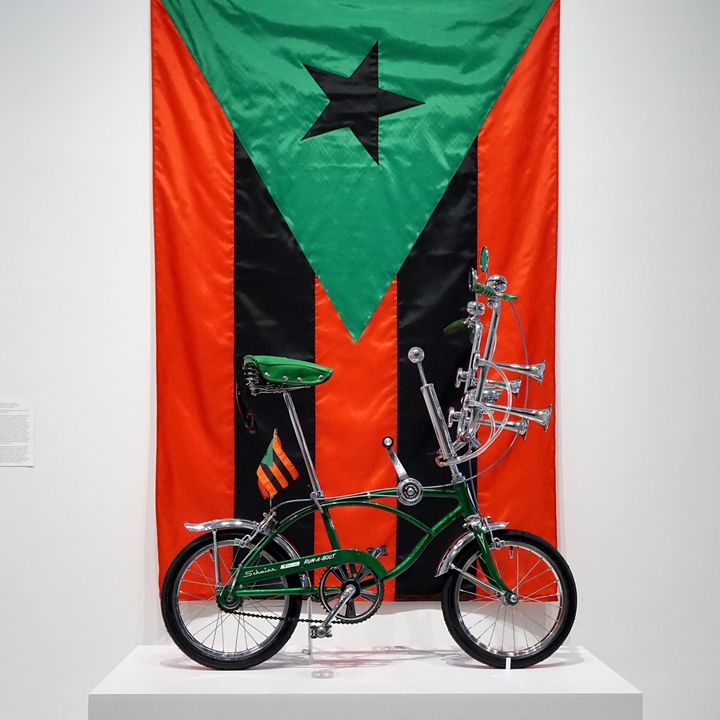
Run-a-Bout, 2017 and Bandera puertorriqueña en rojo, negro, y verde, 2017
MF: What’s the model of these bikes?
ML: It’s a Run-a-Bout, 1969. If there ever was a bike that Schwinn made that suggested freedom and independence it was the run-a-bout. It’s portable. The final bike in the show is the ”Estadista (Statehood’er).” It’s a blue 1968 Schwinn Fastback, the color of the statehood party in P.R. 1968 is the first year that P.R. elected a pro-statehood governor- Luis A. Ferré- and also the year the prop on the back of the bike was made. It’s a hangman’s noose on a sissy bar. There’s never a time when that’s a neutral symbol.
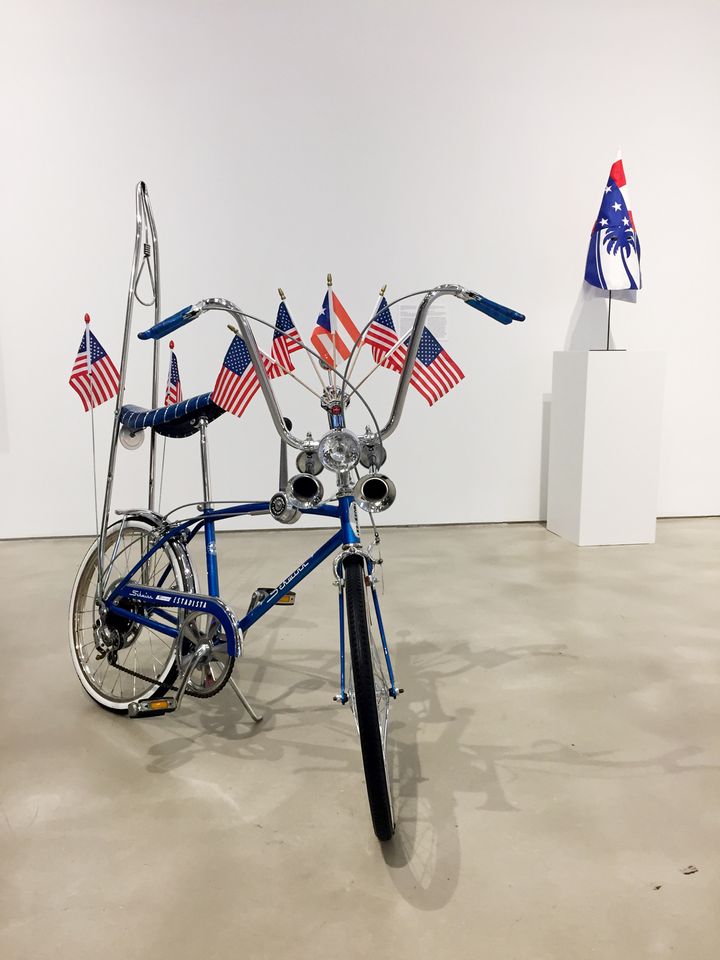
Estadsita (Statehood'er), 2017
MF: Wait? You didn’t make the symbol, it was actually a product on the bike market?
ML: It was made as an aftermarket accessory for children’s bikes, in 1968. Here, it’s presented as an artifact – a painful reminder of racist symbols in American popular culture. 1968 was an intense year of racial violence and civil unrest. For this to be produced in any way suggests a tolerance for racism within the culture and huge blind spots among many in the population that would allow this to be perceived in any way neutral. All of this is paired with the question of how Puerto Rico’s agenda for statehood (past/present) aligns with U.S. administration that has been so openly racist. This bike is paired with the work State-hood, 2017. This is a klan hood made from the flags of Ricky Rossello’s 2016 gubernatorial campaign, who was just elected governor of P.R. So, the question remains: how does statehood align with a U.S. administration that is/was supported by white supremacists. This is an administration that literally has put white supremacists in the White House. You have Bannon and Sessions in the cabinet. The day that Sessions was appointed Attorney General, Rosselló pens a letter congratulating him and then advocates for statehood. My point is that Puerto Rico’s interests are completely at odds with the interests of the current U.S. administration. This isn’t the time to align with this administration.
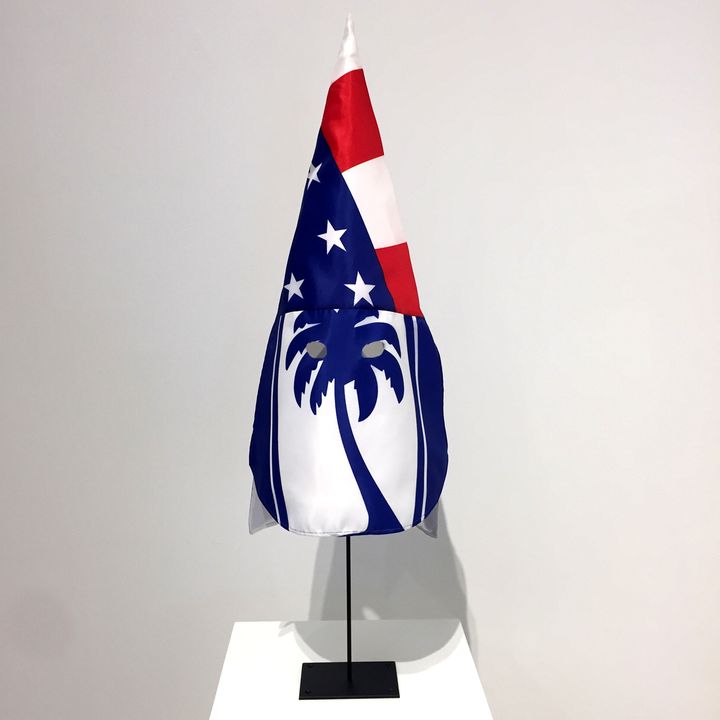
State-hood, 2017
MF: Interesting. I’m of the belief that, ironically, this may be the administration that grants full autonomy to P.R. What do you think?
ML: It’s an interesting proposal. I think people are anxious for another alternative right now, even if different from the three party options. The crisis is challenging people to think of other possibilities. But I think it’s very possible, that the U.S. cuts P.R. off, before the island ever becomes a state. And I believe in independence.
MF: I believe so too. Congratulations on a formidable show.
Miguel Luciano’s Ride or Die exhibit March 5, 2017
Cost: FREE Admission
Location: Gallery at BRIC House
647 Fulton Street
(Enter on Rockwell Place)
Brooklyn, NY 11217
